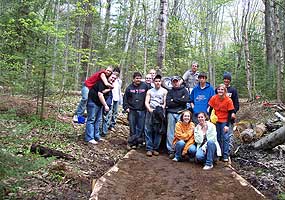 |
 | |
  | |
|
|
|
|
Pictured Rocks National Lakeshore
Tenth, Eleventh, and Twelfth Grade School Programs
|
|
|
|
|
|
 |
|
 |
| NPS photo | | Students worked on this trail |
 |
Tenth Grade - Winter
Global Climate Change and the National Lakeshore
Michigan Science Standards met: Hydrosphere 2, Reflecting on Scientific Knowledge 1
In the classroom, four sessions: Students will view the film “Inconvenient Truth” (96 minutes) during two class sessions. During the third class session, they will break up into groups to debate the validity of the film. During the fourth session, information will be presented on global climate change at Pictured Rocks and other National Parks.
|
Tenth Grade - Spring
Pictured Rocks Maritime History
Michigan Social Studies Standards met: Historical Perspective: Content Standard 1, Geographic Perspective 1 and 3, Economic Perspective 5, Inquiry Standard 1
In the classroom one hour: A PowerPoint program will explain maritime travel along the Pictured Rocks from 1600 to the present. Students will be divided into nine time period groups and read the scripts for short five-minute plays about maritime travel in the area. These performances will be given during the field trip component of this program.
Field trip to Pictured Rocks: All day – bring a lunch! Students will travel to the Kingston Lake picnic area where they will “happen" upon a voyageur from the past. The voyageur will engage the teacher in a lively discussion about the fur trade era in the region.
During their lunch break, students may be given the opportunity to paddle in an authentic Native American-made birch bark canoe the voyageurs might have used. After lunch the group will travel to the Hurricane River Campground to hike a short distance to see shipwreck parts. A shipwreck “survivor” will explain about the wreck and travel on Lake Superior up to the present day.
The program will conclude with nine 5-minute long dramatic presentations by the students, who will re-enact each of the nine important time periods for maritime travel in the area.
|
Tenth Grade - Spring
Pictured Rocks Coast Guard Era – 1930s to 1960s
Michigan Social Studies Standards met: Historical Perspective: Content Standard 2, Civic Perspective: Content Standard 1
In the classroom one hour: A Power Point presentation about the two Coast Guard sites in Munising and Grand Marais including pictures showing some of the people, their drills, and the rescues and attempted rescues they were involved with from the 1930s to the closure of the stations in the 1960s. The program will explain the traffic and cargo on Lake Superior at this time, as well as geographic reasons for building locations.
From newspapers of those time periods, students will learn of significant national, local, and international events. They will get a chance to handle flag signal and Morse code equipment that the Coast Guard would have used. A short video will explain one of the life saving drills practiced. Written accounts of Coast Guard staff will be read and discussed. A map of the Sand Point Coast Guard Station and grounds will be reviewed.
Two-hour field trip to Sand Point Coast Guard Station: Students will tour the grounds of the old Coast Guard site and briefly view the main building. Next they will tour the boathouse and get a first-hand look of the old self-righting motorboat.
The entire class will practice a wigway fire drill. Students will be broken into groups to do different tasks such as servicing the surfboat, and packing the line breeches buoy and tackle into the faking box. Suddenly an emergency signal - in Morse code - will arrive to signal a ship in distress. The “student crew” will hop into action during this simulated rescue reenactment: signaling with flags and pulling a rescue cart to the wreck site. A rescued dummy will be pulled ashore with the breeches buoy. CPR will be performed on the “victim” who eventually is resuscitated. A discussion of the events and the participants’ thoughts and feelings will conclude the field trip.
|
Eleventh and Twelfth Grades - Fall, Winter, and Spring
Wilderness Concept Explored
Michigan Social Studies met: Skills, goals and objectives 1
In the classroom: Working in small groups, students will explore several questions. What is wilderness? Why do some people support it? Why are some people against it? Have you ever experienced “wilderness”? Examine all sides of this issue through in-class readings, discussions, and debate. A “wilderness” field trip could be arranged.
|
Eleventh and Twelfth Grades - Winter
Leave No Trace – Outdoor Skills and Practices Course
Michigan Science Objective met: Constructing Personal Knowledge 8
Classroom and field trip: Students will learn basic winter camping skills and the gear needed for an overnight trip. They will explore methods of leaving no impact or trace of their use of wild land through the study of an outdoor philosophy called “Leave No Trace.” Extra gear and equipment is available.
|
When scheduling a program, please determine your preferred date and a few alternate dates. Please contact:
David Kronk, Park Ranger
Pictured Rocks National Lakeshore
P.O. Box 40
Munising, MI 49862
(906) 387-2607, ext. 206
e-mail
|
|

|
 |
|
|
|
|
|
 |
|
Did You Know?
In 1992, the Pictured Rocks National Lakeshore began installing photovoltaic powered well pump systems at its drive-in campgrounds. All remote water wells within the lakeshore are now solar-powered.
more...
|
|
|
|
Last Updated: January 19, 2007 at 09:04 EST |







